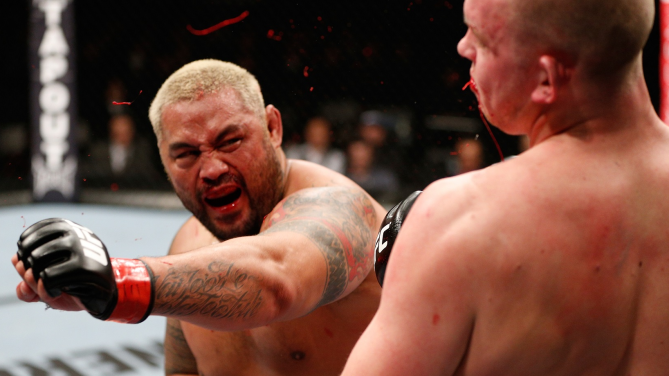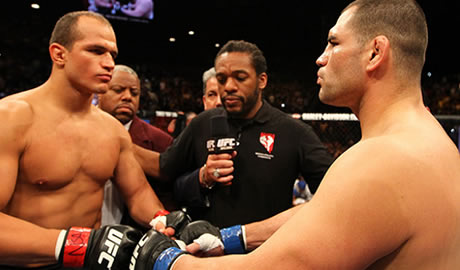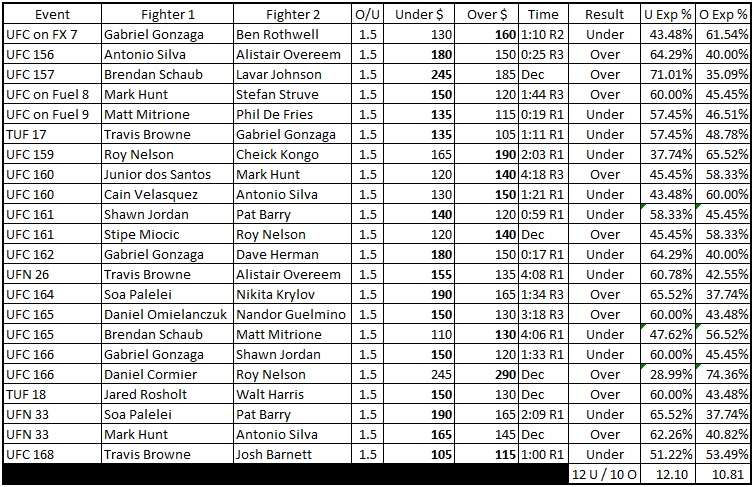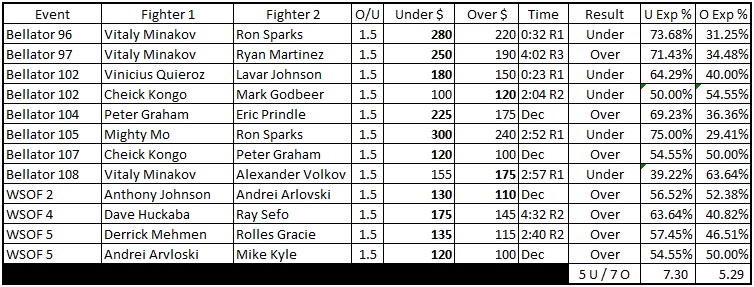 This past weekend, we saw the first two fights in the UFC’s heavyweight division in 2014. Those two fights showed some of the good and bad that can happen in the division. Nikita Krylov shocked everyone by stopping Walt Harris in 25 seconds, exhibiting the big power that heavyweights are often celebrated for. On the other hand, Stipe Miocic and Gabriel Gonzaga showed exactly what happened when the big guys don’t finish early, going a tentative, tired 15 minutes. The contrast of these two fights got me thinking about heavyweight fights in general. It seems like the heavyweight bouts that drag on stand out more in our minds that the one which — as expected — end quickly. But exactly how often do they drag out? How often are they over in the blink of an eye? Our friend Reed Kuhn has already shown that betting lines are historically very accurate, but that analysis just looks at money line odds. How do the betting totals fare, in what is historically the most volatile division in MMA? Due to the dearth of archived round totals in MMA, this examination will be limited to heavyweight fights that occurred in 2013. Furthermore, because of the lack of depth in the division, all UFC, Bellator and WSOF fights that had totals offered are included (Strikeforce held two HW fights in 2013, but I could not find information on the totals). Between the three organizations, there were 64 fight cards in 2013. On those 64 cards, only 43 heavyweight fights offered betting lines, and of those, 42 offered totals (Mighty Mo vs. Dan Charles was the only one that didn’t have a total). That will be our sample size. Of those 42 bouts, 32 ended inside the distance and 10 went to the judges. Of those stoppages, 18 came in the first round, 6 in the second, 7 in the third, and Cain Velasquez holds the only fifth round finish of the bunch, as he stopped Junior dos Santos in the final round at UFC 166. These numbers on their own don’t tell us much however, as we have no baseline as to how long each of those fights was expected to go. That’s where the totals come in. Overwhelmingly — but not surprisingly — the majority of heavyweight fights (34) were set at the lowest possible total, 1.5 rounds. Of the other measured fights, seven were set at 2.5 rounds while the trilogy bout between Cain Velasquez and Junior dos Santos was the only total set in the championship rounds, at 3.5. The tables below show all of the fights in the sample, including where the total was set, what the odds were on each side (taken from Several Bookmakers closing odds), the time the fight took, and if the bout went over or under. Also, the expected percentage outcome attached to each line is presented, as it will be used later in the examination. Click to enlarge.
This past weekend, we saw the first two fights in the UFC’s heavyweight division in 2014. Those two fights showed some of the good and bad that can happen in the division. Nikita Krylov shocked everyone by stopping Walt Harris in 25 seconds, exhibiting the big power that heavyweights are often celebrated for. On the other hand, Stipe Miocic and Gabriel Gonzaga showed exactly what happened when the big guys don’t finish early, going a tentative, tired 15 minutes. The contrast of these two fights got me thinking about heavyweight fights in general. It seems like the heavyweight bouts that drag on stand out more in our minds that the one which — as expected — end quickly. But exactly how often do they drag out? How often are they over in the blink of an eye? Our friend Reed Kuhn has already shown that betting lines are historically very accurate, but that analysis just looks at money line odds. How do the betting totals fare, in what is historically the most volatile division in MMA? Due to the dearth of archived round totals in MMA, this examination will be limited to heavyweight fights that occurred in 2013. Furthermore, because of the lack of depth in the division, all UFC, Bellator and WSOF fights that had totals offered are included (Strikeforce held two HW fights in 2013, but I could not find information on the totals). Between the three organizations, there were 64 fight cards in 2013. On those 64 cards, only 43 heavyweight fights offered betting lines, and of those, 42 offered totals (Mighty Mo vs. Dan Charles was the only one that didn’t have a total). That will be our sample size. Of those 42 bouts, 32 ended inside the distance and 10 went to the judges. Of those stoppages, 18 came in the first round, 6 in the second, 7 in the third, and Cain Velasquez holds the only fifth round finish of the bunch, as he stopped Junior dos Santos in the final round at UFC 166. These numbers on their own don’t tell us much however, as we have no baseline as to how long each of those fights was expected to go. That’s where the totals come in. Overwhelmingly — but not surprisingly — the majority of heavyweight fights (34) were set at the lowest possible total, 1.5 rounds. Of the other measured fights, seven were set at 2.5 rounds while the trilogy bout between Cain Velasquez and Junior dos Santos was the only total set in the championship rounds, at 3.5. The tables below show all of the fights in the sample, including where the total was set, what the odds were on each side (taken from Several Bookmakers closing odds), the time the fight took, and if the bout went over or under. Also, the expected percentage outcome attached to each line is presented, as it will be used later in the examination. Click to enlarge.
With this data, we now know that 23 heavyweight fights ended under their assigned total last year, while 19 went over. Obviously the totals were set pretty accurately with that kind of split, but there’s still one more factor to consider before we break things down further, and it’s the most important: the betting lines. Out of the 34 totals set at 1.5 rounds, the under was the favored side on 24 occasions (indicated by bold in the tables), meaning that oddsmakers expected those fights to end in the first seven and a half minutes more times than not. The same pattern held true in the eight bouts set with higher round totals, as six had the under favored, one had the over favored, and one was a pick ’em when the lines closed. Taking those figures into account, the under was expected to hit in 24.27 bouts, while the over was thought to be the side 19.58 times. Overall, those numbers are very accurate compared to the actual results of 23 and 19. Also, those expected totals add up to just under 44 bouts, which is because totals don’t receive the same kind of reduced juice at books as money lines. The extra vig involved with betting totals is something to keep in mind, as over time it will certainly cut into your profits. That doesn’t mean that you should necessarily stay away from totals, as there is certainly money to be made if you look in the right places. For instance, throwing the UFC numbers out and looking just at Bellator and WSOF (tables 2 and 4), we find that the unders were overvalued in 2013. In those 14 bouts, 8.61 were expected to go under, and 6.09 over, when in reality it was an even split of seven and seven. Some of the fights that went over were horrid to watch (Dave Huckaba/Ray Sefo, and Peter Graham/Eric Prindle, to name two), but money is money, no matter how it comes.  The slight inaccuracy in the non-UFC odds could be attributed to overvaluing the finishing abilities of heavyweights who aren’t quite at the highest level, or simply undervaluing the toughness of their opponents — who are often times fighters who have previously been finished at the top level themselves. I would imagine it’s a combination of those two factors, or the sample in play could be so small that it would correct over time. However, this trend doesn’t just hold true at the lower level, as it carries over to fighters making their UFC debuts as well. Daniel Cormier, Nikita Krylov, Daniel Omielanczuk, Nandor Guelmino, Jared Rosholt and Walt Harris all saw their first fight in the Octagon go over the assigned total. Perhaps another area to zone in on is when the total is set above 1.5. Though this only occurred in eight instances across all of 2013, six of those went under. The two that didn’t were the aforementioned Velasquez/dos Santos 3, and Cormier’s UFC debut against Mir. As an aside, Cormier was one of only two heavyweights to win two bouts that went over in 2013, Mark Hunt was the other — and was the only one involved in three fights to go over. What a cardio machine. Of the eight bouts set at 2.5 (or higher), the expectation was for 4.87 to go under, and 3.48 to go over, so the actual results of six and two indicate some disparity, albeit (once again) in a minuscule sample size. When I first started compiling these numbers, I expected to find a large trend pointing at either the over or under holding quite a bit of hidden value, but in the end, it couldn’t be further from the truth. Just as with money lines, it seems oddsmakers do an excellent job of setting the totals accurately over the long run, even in a division that can be as chaotic and unpredictable as heavyweight. Of course this doesn’t mean spots won’t pop up that present value (for instance, Roy Nelson vs. fighters who don’t circle into his right hand), just that selectivity is key. The one spot that I’ll be sure to take a closer look at in 2014 are when heavyweights have their total set above 1.5, given how often they went under that mark in 2013. The trade-off is that you usually have to pay a bit of juice to get these lines, but early results still show some value. Keep an eye out throughout the rest of 2014, as I continue to look at the numbers in an effort to see if we can’t find an edge when betting this crazy sport.
The slight inaccuracy in the non-UFC odds could be attributed to overvaluing the finishing abilities of heavyweights who aren’t quite at the highest level, or simply undervaluing the toughness of their opponents — who are often times fighters who have previously been finished at the top level themselves. I would imagine it’s a combination of those two factors, or the sample in play could be so small that it would correct over time. However, this trend doesn’t just hold true at the lower level, as it carries over to fighters making their UFC debuts as well. Daniel Cormier, Nikita Krylov, Daniel Omielanczuk, Nandor Guelmino, Jared Rosholt and Walt Harris all saw their first fight in the Octagon go over the assigned total. Perhaps another area to zone in on is when the total is set above 1.5. Though this only occurred in eight instances across all of 2013, six of those went under. The two that didn’t were the aforementioned Velasquez/dos Santos 3, and Cormier’s UFC debut against Mir. As an aside, Cormier was one of only two heavyweights to win two bouts that went over in 2013, Mark Hunt was the other — and was the only one involved in three fights to go over. What a cardio machine. Of the eight bouts set at 2.5 (or higher), the expectation was for 4.87 to go under, and 3.48 to go over, so the actual results of six and two indicate some disparity, albeit (once again) in a minuscule sample size. When I first started compiling these numbers, I expected to find a large trend pointing at either the over or under holding quite a bit of hidden value, but in the end, it couldn’t be further from the truth. Just as with money lines, it seems oddsmakers do an excellent job of setting the totals accurately over the long run, even in a division that can be as chaotic and unpredictable as heavyweight. Of course this doesn’t mean spots won’t pop up that present value (for instance, Roy Nelson vs. fighters who don’t circle into his right hand), just that selectivity is key. The one spot that I’ll be sure to take a closer look at in 2014 are when heavyweights have their total set above 1.5, given how often they went under that mark in 2013. The trade-off is that you usually have to pay a bit of juice to get these lines, but early results still show some value. Keep an eye out throughout the rest of 2014, as I continue to look at the numbers in an effort to see if we can’t find an edge when betting this crazy sport.



